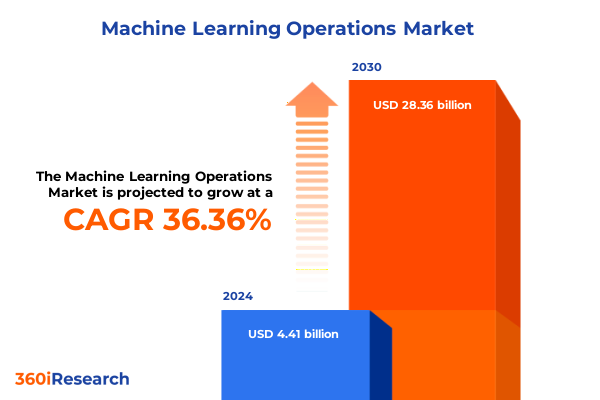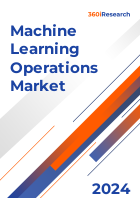The Machine Learning Operations Market size was estimated at USD 4.41 billion in 2024 and expected to reach USD 6.04 billion in 2025, at a CAGR 36.36% to reach USD 28.36 billion by 2030.

Introduction to Machine Learning Operations
In an era defined by rapid digital transformation, Machine Learning Operations (MLOps) has emerged as a critical discipline for organizations seeking to deliver reliable, scalable, and secure AI solutions. By integrating development, deployment, and monitoring of machine learning models into a unified lifecycle, MLOps ensures that data-driven initiatives move seamlessly from experimentation to production. This introduction outlines how MLOps addresses growing complexities-ranging from version control and continuous integration to governance and reproducibility-while enabling cross-functional teams to collaborate effectively. With enterprises contending with increasing data volumes, evolving regulatory requirements, and heightened competitive pressures, adopting a structured MLOps framework has shifted from a luxury to a strategic imperative. The following sections explore the pivotal shifts driving this emergence, assess external factors such as trade policy impacts, and deliver granular insights across market segments, regions, and leading players. Finally, we offer actionable guidance and next steps for leaders aiming to harness MLOps to accelerate innovation, optimize operational efficiency, and achieve enterprise-grade performance in AI deployments.
Transformative Shifts Reshaping Machine Learning Operations
The MLOps landscape has transformed markedly in recent years, propelled by advances in AI-powered platforms that streamline model development and robust automation tools that replace manual handoffs. Cloud integration has grown indispensable, offering elastic compute and storage capabilities that underpin large-scale training and inference workloads. Meanwhile, the convergence of DevOps best practices with machine learning workflows has elevated continuous deployment and monitoring to new heights of sophistication. Data governance frameworks now factor in privacy regulations and ethical considerations, forging tighter alignment between technical teams and compliance functions. Emerging technologies such as blockchain for auditability and robotic process automation for orchestration are redefining how models move through test, validation, and production stages. Collectively, these shifts are creating a more resilient, transparent, and agile environment in which AI initiatives can thrive.
Cumulative Impact of United States Tariffs on MLOps in 2025
The introduction of new United States tariffs in 2025 has had a pronounced impact on the cost structure and supply chain dynamics for organizations deploying MLOps infrastructure. Hardware components such as GPUs and networking equipment have experienced duty increases, prompting providers of AI-Powered Platforms and Automation Tools to adjust pricing or seek alternative sourcing strategies. Cloud integration providers have responded by expanding local data center footprints to mitigate import costs and ensure service continuity. At the same time, software licensing models for CRM Solutions and third-party service connectors have been re-evaluated to offset higher operational expenses. In reaction, many enterprises are accelerating shifts toward containerized deployments and hybrid solutions that reduce reliance on imported hardware. This environment underscores the importance of flexible deployment models and strategic vendor partnerships to maintain cost predictability while advancing AI and machine learning initiatives.
Key Segmentation Insights Across Solutions, Verticals, and Functions
A deep dive into market segmentation reveals how diverse requirements shape the adoption of MLOps capabilities. Based on Software Solutions, organizations evaluate AI-Powered Platforms versus Automation Tools, Cloud Integration services and CRM Solutions to align with their development priorities. Across Industry Verticals, the breadth of use cases spans the Finance Sector-where Investment Management and Retail Banking teams seek predictive analytics-to the Healthcare Sector, which leverages Electronic Health Records and Telemedicine Applications, and the Manufacturing Sector, focused on IoT-Driven Manufacturing and Smart Factory Solutions. From a Business Functions perspective, Human Resources teams adopt Employee Engagement Platforms and Recruitment Tools, Operations groups integrate Process Automation and Workflow Optimization, and Sales & Marketing deploy Marketing Automation alongside Sales Analytics. In terms of Technology Type, enterprises weigh Artificial Intelligence offerings, from Machine Learning Algorithms to Natural Language Processing, against Blockchain Technologies and Robotic Process Automation. Deployment Models range from Cloud-Based Solutions-both Private Cloud and Public Cloud-to Hybrid Solutions and On-Premise Solutions. End-User Industry requirements vary across Automotive with Connected Vehicles, Energy & Utilities implementing Smart Grid Systems, and Retail & E-commerce embracing Omnichannel Platforms. User Size distinctions between Large Enterprises, Medium Enterprises and Small Enterprises influence scalability and licensing considerations. Data Types-whether Structured Data or Unstructured Data-drive tooling choices and preprocessing workflows. Pay Model preferences for Pay-Per-Use versus Subscription-Based licensing shape procurement strategies, while Integration Capabilities-via API Integrations or Third-Party Service Connectors-determine interoperability within existing IT ecosystems.
This comprehensive research report categorizes the Machine Learning Operations market into clearly defined segments, providing a detailed analysis of emerging trends and precise revenue forecasts to support strategic decision-making.
- Software Solutions
- Industry Verticals
- Business Functions
- Technology Type
- Deployment Models
- End-User Industry
- User Size
- Data Types
- Pay Model
- Integration Capabilities
Key Regional Insights Across Major Global Markets
Regional dynamics play a decisive role in the evolution of MLOps adoption. In the Americas, a mature ecosystem of cloud providers, AI-powered platforms and automation tool vendors drives rapid innovation, supported by strong investment in research centers and developer communities. Regulatory frameworks around data privacy and security in North America encourage best practices for model governance and auditability. In Europe, Middle East & Africa, compliance with GDPR and emerging AI ethics guidelines has elevated the importance of transparent, explainable workflows, while markets in the Middle East invest heavily in smart city and energy infrastructure projects. In Asia-Pacific, widespread digital transformation initiatives across government and enterprise sectors fuel demand for scalable cloud integration, with countries like China, India and Australia leading deployment of hybrid and on-premise solutions to address data sovereignty requirements.
This comprehensive research report examines key regions that drive the evolution of the Machine Learning Operations market, offering deep insights into regional trends, growth factors, and industry developments that are influencing market performance.
- Americas
- Asia-Pacific
- Europe, Middle East & Africa
Key Companies Driving Innovation in MLOps
The competitive landscape features global hyperscale providers and niche innovators competing for MLOps leadership. Industry giants such as Amazon Web Services, Inc., Google LLC by Alphabet Inc., Microsoft Corporation and International Business Machines Corporation integrate MLOps toolchains into their cloud platforms, offering managed services that cover everything from model training to monitoring. Enterprise software leaders including Oracle Corporation, SAP SE and SAS Institute Inc. embed MLOps capabilities within broader analytics suites, while specialized vendors like DataRobot, Inc., Dataiku and H2O.ai, Inc. emphasize automated model development and explainability. Companies such as BigML Inc., Domino Data Lab, Inc. and Anyscale, Inc. focus on scalable pipeline orchestration, whereas open-source contributors like Canonical Ltd. and Iguazio Ltd. by McKinsey & Company champion Kubernetes-native MLOps. Other innovators-including Addepto Sp. z o. o., Allegro Artificial Intelligence Ltd., Gathr Data Inc., Grid Dynamics Holdings, Inc., Alibaba Cloud International, Anyscale, Inc., Neal Analytics, Neptune Labs, Inc., Neuro Inc., Runai Labs Ltd., SAP SE, Tredence Analytics Solutions Pvt. Ltd., understandAI GmbH, Valohai, Virtusa Corporation and Weights and Biases, Inc.-deliver specialized solutions across areas such as automated feature engineering, real-time inference and model governance integrations.
This comprehensive research report delivers an in-depth overview of the principal market players in the Machine Learning Operations market, evaluating their market share, strategic initiatives, and competitive positioning to illuminate the factors shaping the competitive landscape.
- Addepto Sp. z o. o.
- Alibaba Cloud International
- Allegro Artificial Intelligence Ltd.
- Amazon Web Services, Inc.
- Anyscale, Inc.
- BigML Inc.
- Canonical Ltd.
- Dataiku
- DataRobot, Inc.
- Domino Data Lab, Inc.
- Gathr Data Inc.
- Google LLC by Alphabet Inc.
- Grid Dynamics Holdings, Inc.
- H2O.ai, Inc.
- Hewlett Packard Enterprise Company
- Iguazio Ltd. by McKinsey & Company
- International Business Machines Corporation
- Microsoft Corporation
- Neal Analytics
- Neptune Labs, Inc.
- Neuro Inc.
- Oracle Corporation
- Runai Labs Ltd.
- SAP SE
- SAS Institute Inc.
- Tredence Analytics Solutions Pvt. Ltd.
- understandAI GmbH
- Valohai
- Virtusa Corporation
- Weights and Biases, Inc.
Actionable Recommendations for Industry Leaders
Leaders looking to capitalize on MLOps should prioritize seamless integration of continuous development and deployment pipelines, ensuring that data scientists and DevOps engineers collaborate through shared platforms and unified tooling. They should adopt hybrid deployment strategies that balance the flexibility of public cloud with the security of on-premise or private cloud environments while optimizing for data residency requirements. Investment in robust data governance frameworks and explainable AI ensures compliance with evolving regulations and builds stakeholder trust. Organizations must develop cross-functional upskilling programs to expand proficiency in machine learning algorithms, natural language processing and RPA, embedding MLOps best practices into every stage of the model lifecycle. Strategic partnerships with hyperscale cloud providers, boutique AI consultancies and integration-focused vendors will streamline vendor management and accelerate time to value. Finally, adopting usage-based and subscription licensing models enables cost visibility and aligns expenditures with business outcomes.
Explore AI-driven insights for the Machine Learning Operations market with ResearchAI on our online platform, providing deeper, data-backed market analysis.
Ask ResearchAI anything
World's First Innovative Al for Market Research
Conclusion on Achieving Strategic Value with MLOps
In summary, MLOps has transitioned from a niche technical practice to a mission-critical capability for enterprises seeking to operationalize AI at scale. The amalgamation of automation tools, cloud integration, governance frameworks and emerging technologies such as blockchain and RPA has created an ecosystem capable of sustaining continuous innovation. Tariff pressures in 2025 have underscored the importance of flexible sourcing and deployment models, while diverse requirements across industry verticals, business functions and regional markets highlight the need for tailored strategies. By aligning organizational structures, investing in upskilling and forging strategic partnerships, leaders can unlock the full potential of machine learning operations and secure a competitive edge.
This section provides a structured overview of the report, outlining key chapters and topics covered for easy reference in our Machine Learning Operations market comprehensive research report.
- Preface
- Research Methodology
- Executive Summary
- Market Overview
- Market Dynamics
- Market Insights
- Cumulative Impact of United States Tariffs 2025
- Machine Learning Operations Market, by Software Solutions
- Machine Learning Operations Market, by Industry Verticals
- Machine Learning Operations Market, by Business Functions
- Machine Learning Operations Market, by Technology Type
- Machine Learning Operations Market, by Deployment Models
- Machine Learning Operations Market, by End-User Industry
- Machine Learning Operations Market, by User Size
- Machine Learning Operations Market, by Data Types
- Machine Learning Operations Market, by Pay Model
- Machine Learning Operations Market, by Integration Capabilities
- Americas Machine Learning Operations Market
- Asia-Pacific Machine Learning Operations Market
- Europe, Middle East & Africa Machine Learning Operations Market
- Competitive Landscape
- ResearchAI
- ResearchStatistics
- ResearchContacts
- ResearchArticles
- Appendix
- List of Figures [Total: 36]
- List of Tables [Total: 940 ]
Call-To-Action: Secure Your Comprehensive MLOps Market Research Report
Ready to gain deeper insights and access a comprehensive market research report on Machine Learning Operations? Contact Ketan Rohom (Associate Director, Sales & Marketing at 360iResearch) today to secure detailed analysis, segmentation breakdowns and strategic recommendations. Reach out via email at [email protected] or call +1-123-456-7890 to learn how this report can guide your AI transformation journey.

- How big is the Machine Learning Operations Market?
- What is the Machine Learning Operations Market growth?
- When do I get the report?
- In what format does this report get delivered to me?
- How long has 360iResearch been around?
- What if I have a question about your reports?
- Can I share this report with my team?
- Can I use your research in my presentation?




